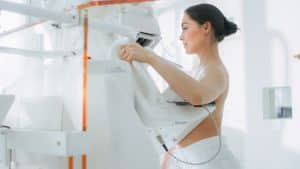The Importance of Mammograms

What Are Mammograms?
A mammogram is simply an x-ray of the breast designed to detect tiny abnormalities. There are two kinds of mammograms:
Screening Mammogram
An x-ray consisting of four separate images of breast tissue for healthy women with no prior cases of breast cancer.
Diagnostic Mammogram
Additional x-rays after an initial screening for women with symptoms (lumps, pain, or nipple discharge) taken at different angles to help pinpoint an abnormality that may be breast cancer
Who Needs a Mammogram?
Women aged 40 to 74 should get a yearly or bi-annual mammogram (or as recommended by your doctor) to screen for breast cancer. Additional guidelines include:
Ages 39 and under: Mammograms aren’t recommended unless you’ve tested positive for BRCA1 or BRCA2 gene mutation, have had many x-rays of the chest wall, or have an extreme family history of breast cancer
Ages 40-74: Get a yearly mammogram if you have a first-degree relative (mother, daughter, grandmother, or sister) who’s been diagnosed with breast cancer
Ages 40-49: If you have no family history of breast cancer, talk to your doctor to review the pros and cons of getting a mammogram
Ages 50-74: Get a mammogram every other year if you have no symptoms or family history of breast cancer
Ages 74 and older: Talk to your doctor about the pros and cons of mammography
What Should I Expect During My Mammogram?
When you receive your mammogram, a technologist will place your breast on a plastic plate where it will be compressed to expose as much breast tissue as possible in a thin, even layer. The test proceeds with two x-rays of the breast and is then repeated on the other breast. Each breast will be compressed for about 10 seconds.
Let your technologist know if you experience significant discomfort during breast compression so that she can try to make you more comfortable. Things you can do to make your mammogram go as smoothly as possible include:
- Taking a dose of acetaminophen or ibuprofen before your appointment
- Scheduling your mammogram a week after your period when your breasts are least tender
- Not wearing deodorant to your appointment since it contains particles that can appear on your x-rays
Benefits of Mammograms
Mammograms offer many benefits to women who undergo regular screening.
Safe
Mammograms use a tiny amount of radiation that won’t pose a health risk.
Effective
Early detection of breast cancer decreases your chances of dying of the disease by 25-30%.
Easy
A mammogram appointment usually takes only 20 minutes, and many centers give you the results of your screening the same day.
Visit PURE Mammography for Your Next Mammogram
When you need a mammogram, visit PURE Mammography inside Smith Haven Mall in Lake Grove on Long Island. No appointment is necessary, and we have convenient evening and weekend hours. Contact us today for more information on our state-of-the-art facility.